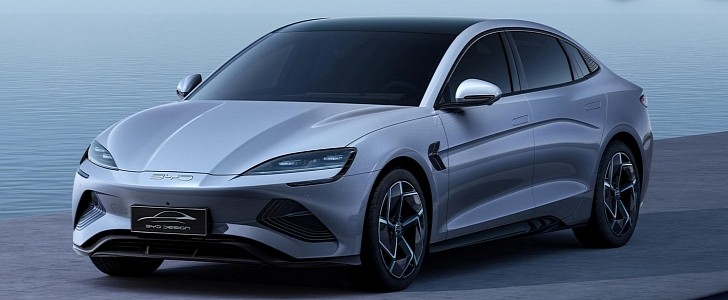The Chinese MIIT (Ministry of Industry and Information Technology) usually anticipates crucial information about important cars about to hit the Chinese market and the world. On March 15, we learned almost everything that was to know about the BYD Seal. The Chinese automaker waited a bit to start its pre-sales and reveal perhaps the most important information about the new EV: its prices.
The Seal starts at RMB212,800 ($31,795 at the current exchange rate) “after comprehensive subsidy” – in other words, only with the government’s help. It would be useful to learn how much BYD would charge for it if China did not make it a priority to sell NEVs (New Energy Vehicles).
That money will give customers a derivative with a 150-kW (201 hp) rear motor, 1,885 kilograms (4,156 pounds), and 550 kilometers (342 miles) of range with a 61.4-kWh battery pack according to the CLTC cycle. Just to remember, the new EV is 4.80 meters (189 inches) long, 1.88 m (74 in) wide, 1.46 m (57.5 in) tall, and has a wheelbase of 2.92 m (115 in).
With the same incentives, Tesla charges RMB279,900 ($41,820) for the entry-level Model 3, which promises a similar range with LFP batteries. That kind of money could buy you the fully-loaded Seal, but we’ll get there.
For RMB225,800 ($33,737), BYD clients can take home the Seal Premium, which comes with more content. The Long Range edition costs RMB262,800 ($39,265) and comes with two significant changes. The one that helps name this derivative is a bigger battery pack: the 82.5-kWh capacity gives it 700 km (435 mi) of range. The other is a stronger rear motor, with 230 kW (308 hp).
The Performance version of the Seal just adds a 160-kW (214.6-hp) front motor to the Long Range package, making it an AWD vehicle. This derivative costs RMB289,800 ($43,299) and it is the heaviest one, weighing 2,150 kg (4,740 lb). We know that thanks to MIIT: BYD did not disclose the weight of the other two derivatives. The additional mass and power reduce the range to 650 km (404 mi).
The top speed is electronically limited to 180 kph (112 mph) in all derivatives. What changes is the acceleration time from 0 to 100 kph. The Seal Elite and Premium do that in 7.5 seconds. The Long Range hits the target speed in 5.9 s, and the Performance gets there in 3.8 s. The Seal has a drag coefficient of just 0.219.
Perhaps the most impressive thing about this gorgeous car is what Antutu also stresses: its CTB (cell-to-body) system. A development of the CTP (cell-to-pack) assembly system, it installs the LFP Blade Batteries directly into the ca'sr structure. Although that saves weight and increased energy density, we would love to learn more about it to understand how it can affect repairability.
That may be less of a concern when considering that the Blade Batteries can last for 1.2 million km (745,645.4 mi). Although that can mean they may live longer than the car itself, it also suggests any crash that affects the batteries will make the Seal a write-off. We’ll try to learn more about that from BYD.
That money will give customers a derivative with a 150-kW (201 hp) rear motor, 1,885 kilograms (4,156 pounds), and 550 kilometers (342 miles) of range with a 61.4-kWh battery pack according to the CLTC cycle. Just to remember, the new EV is 4.80 meters (189 inches) long, 1.88 m (74 in) wide, 1.46 m (57.5 in) tall, and has a wheelbase of 2.92 m (115 in).
With the same incentives, Tesla charges RMB279,900 ($41,820) for the entry-level Model 3, which promises a similar range with LFP batteries. That kind of money could buy you the fully-loaded Seal, but we’ll get there.
For RMB225,800 ($33,737), BYD clients can take home the Seal Premium, which comes with more content. The Long Range edition costs RMB262,800 ($39,265) and comes with two significant changes. The one that helps name this derivative is a bigger battery pack: the 82.5-kWh capacity gives it 700 km (435 mi) of range. The other is a stronger rear motor, with 230 kW (308 hp).
The Performance version of the Seal just adds a 160-kW (214.6-hp) front motor to the Long Range package, making it an AWD vehicle. This derivative costs RMB289,800 ($43,299) and it is the heaviest one, weighing 2,150 kg (4,740 lb). We know that thanks to MIIT: BYD did not disclose the weight of the other two derivatives. The additional mass and power reduce the range to 650 km (404 mi).
The top speed is electronically limited to 180 kph (112 mph) in all derivatives. What changes is the acceleration time from 0 to 100 kph. The Seal Elite and Premium do that in 7.5 seconds. The Long Range hits the target speed in 5.9 s, and the Performance gets there in 3.8 s. The Seal has a drag coefficient of just 0.219.
Perhaps the most impressive thing about this gorgeous car is what Antutu also stresses: its CTB (cell-to-body) system. A development of the CTP (cell-to-pack) assembly system, it installs the LFP Blade Batteries directly into the ca'sr structure. Although that saves weight and increased energy density, we would love to learn more about it to understand how it can affect repairability.
That may be less of a concern when considering that the Blade Batteries can last for 1.2 million km (745,645.4 mi). Although that can mean they may live longer than the car itself, it also suggests any crash that affects the batteries will make the Seal a write-off. We’ll try to learn more about that from BYD.








